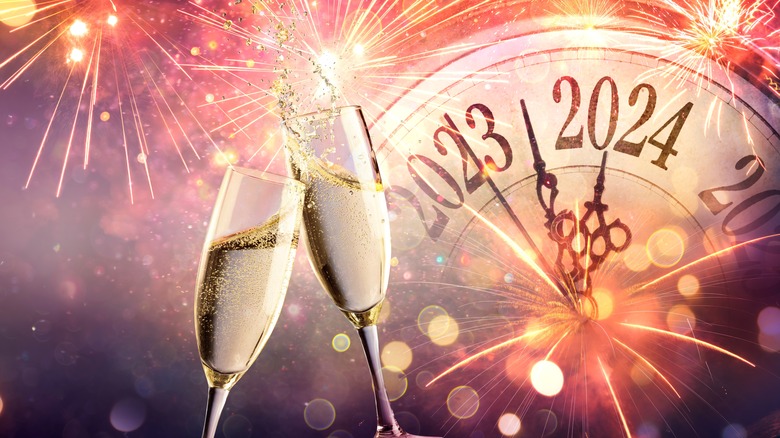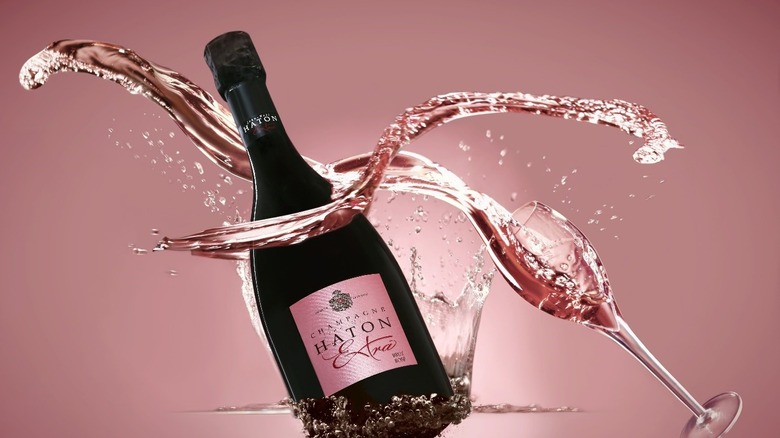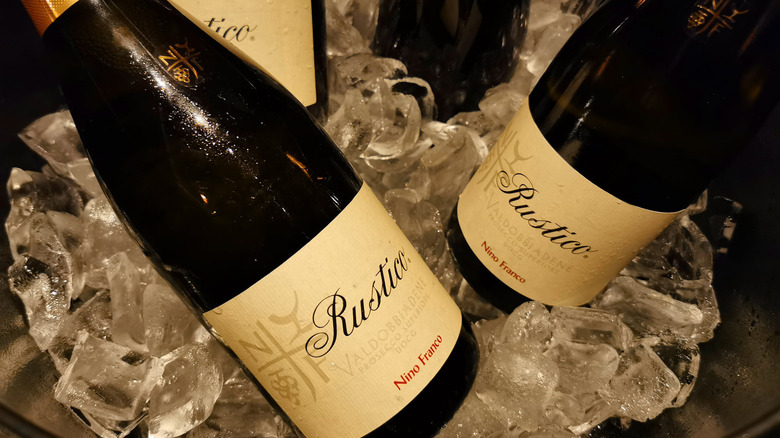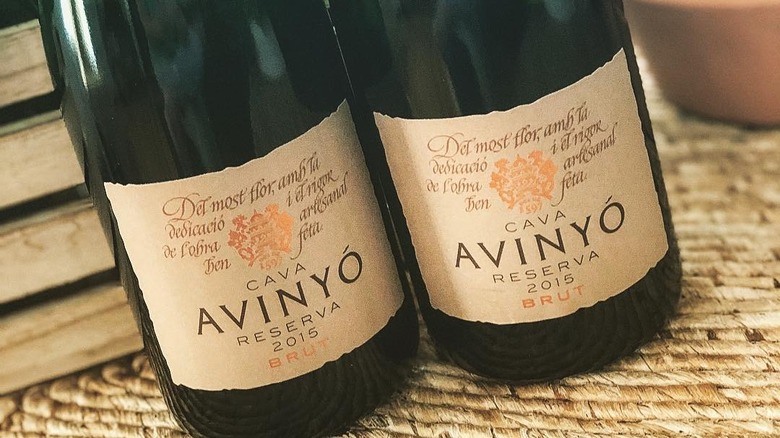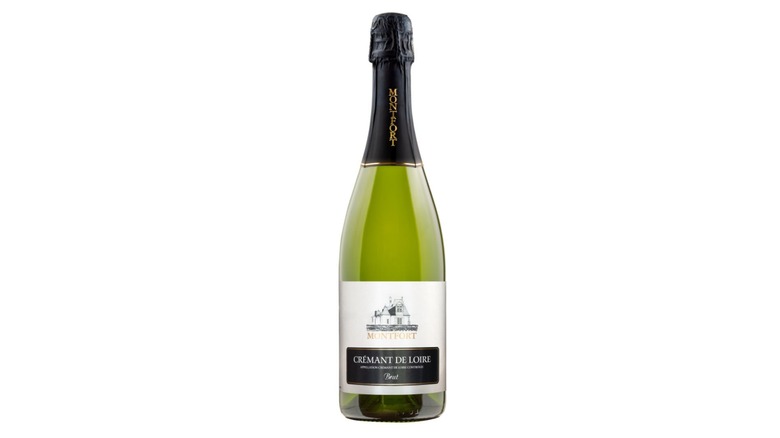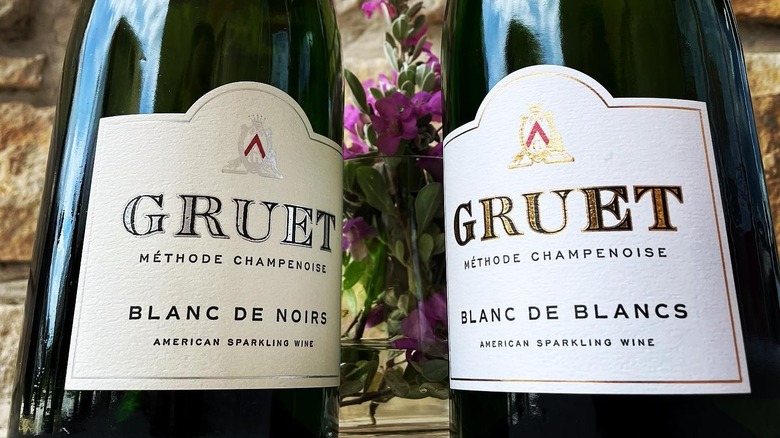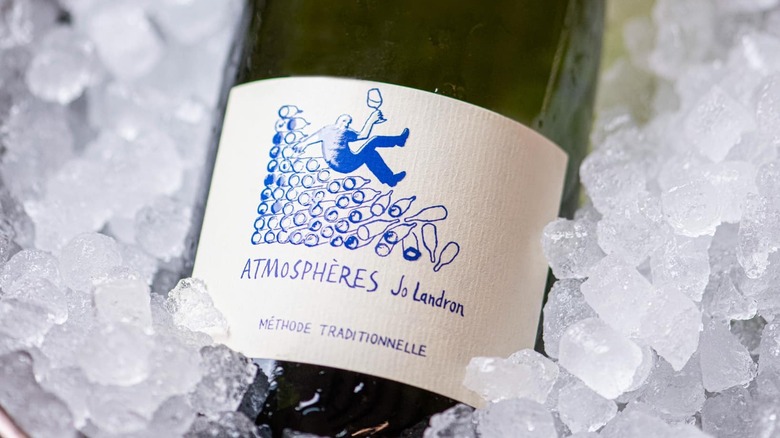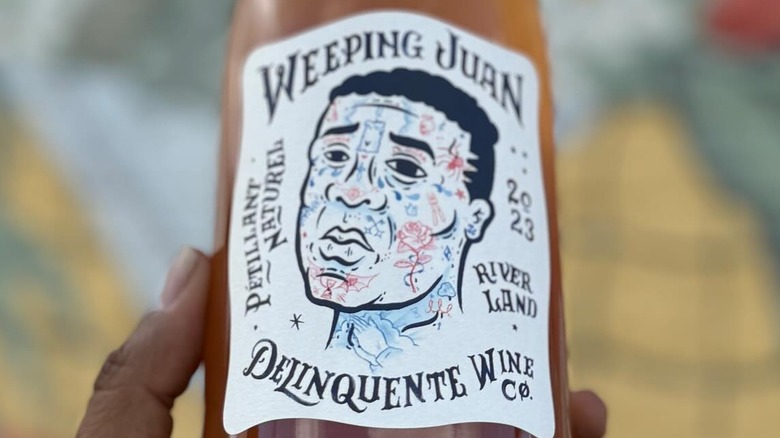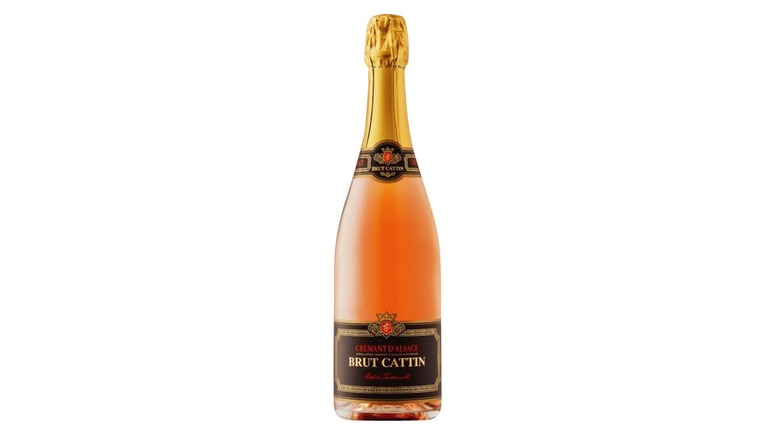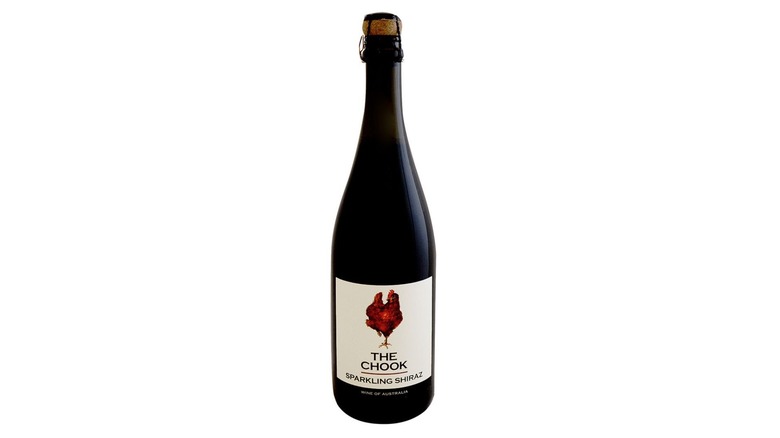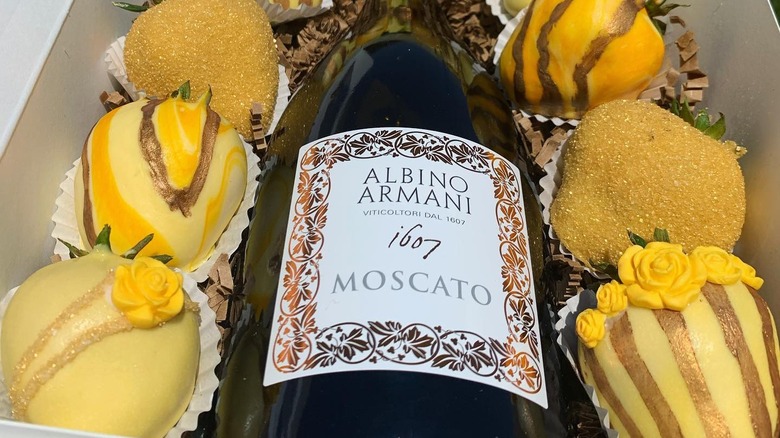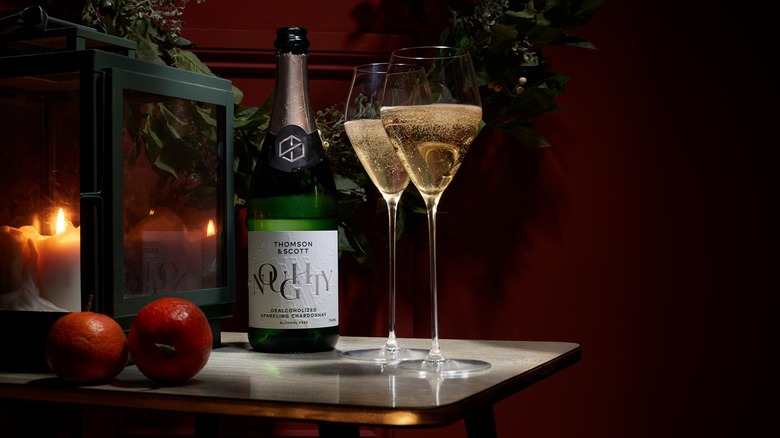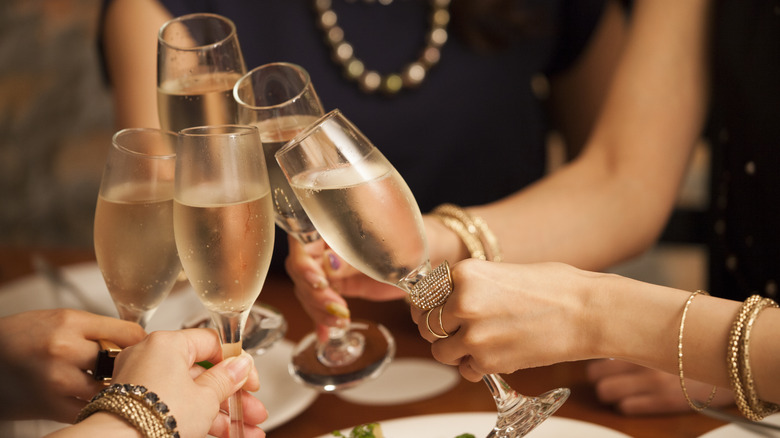Best Champagne And Sparkling Wine Brands Under $30 For New Year's Eve
There's nothing better for toasting in the New Year – or toasting out the old one — than a glass of bubbles. Finding real champagne for under the $30 mark can be a bit challenging for reasons we'll get into; fortunately, there are some fantastic, affordable sparkling alternatives to be found.
Champagne is different from other sparkling wines in that it's strictly protected under French law – it must have been produced in the Champagne region of France under tightly regulated methods. Now, champagne isn't the only sparkling wine to have a protected status in its country of origin, and it's not even the only one to be made using what's known as méthode traditionnelle, or the "traditional method." There's also the fact that some people don't particularly like the taste of typical champagne, and another style of wine might be more enjoyable.
So, if your budget this New Year's Eve means you're looking for bottles of bubbly that come in at under $30 a pop, the options below should have all of your bases covered. I've been lucky enough to try many of these brands myself through my career in the hospitality industry, with recommendations from various sommeliers, and even a Master of Wine. For those I know by reputation only, I've turned to highly-regarded wine rating systems to determine their quality. I've also considered the consistency of quality, as factors outside the winemaker's control can cause variations from year to year.
12. Best overall: Jean-Noël Haton
Although our best overall brand for under $30 is the only true champagne on the list, there's a good reason why. Ultimately, the price of genuine French champagne means it's challenging to find on that budget unless you're willing to settle on a half-sized bottle or less — nice for a stocking filler but not always ideal for New Year's Eve.
Part of the reason champagne commands a higher price is its reputation, but its production methods are also somewhat to blame. The méthode traditionnelle is time-consuming and labor-intensive, requiring hand-rotating individual bottles while secondary fermentation is taking place inside, which is responsible for the wine's effervescence. Some vintages are also aged longer than others, adding to cellaring costs.
However, Jean-Noël Haton has managed to create an impressive range of lower-cost expressions to complement its more expensive offerings. The Brut Classic, considered Very Good by Wine Enthusiast, is a bright and creamy champagne, with a stone fruit and citrus bouquet, while the Brut Reserve is similarly rated with a touch more smoke and dark fruit. Both are deemed just shy of Excellent and are extremely well-balanced — dry but with a touch of sweetness, increasing their versatility.
Purchase Jean-Noël Haton Brut Classic at Burlington Wine & Spirits for $29.99.
Purchase Jean-Noël Haton Brut Reserve at The Wine Buyer for $29.98.
11. Best Prosecco: Nino Franco
Over the years, Prosecco has struggled to achieve the same sort of association that champagne has with luxury and celebration. Instead, it's usually relegated to brunches and summer picnics.
Fortunately, it seems that people are embracing what makes Prosecco different from champagne and taking advantage of its affordability. Prosecco is also a protected name and must be produced in the Veneto or Friuli Venezia Giulia regions in Italy, and mainly from the Glera grape varietal. Prosecco is also less expensive because it uses what's known as the Charmat method as opposed to the more costly méthode traditionnelle. Rather than secondary fermentation occurring in each bottle, it happens in large, pressurized tanks. The result is a wine that's lighter and fruitier — admittedly less complex, but far more affordable.
Located in the famous Italian wine-making town of Valdobbiadene, at the foot of the Dolomite mountains, Nino Franco is one of the oldest wineries in the area, with vines more than 100 years old. The terroir results in a delicate wine that offers crisp orchard fruits with floral elements, making it ideal for sipping on its own or pairing with New Year hors d'oeuvres or canapés, and Wine Enthusiast's scoring system has given it a "Superb" rating, with 94 points out of 100.
Purchase Nino Franco Rustico Prosecco DOCG at Uncorked for $29.99.
Purchase Nino Franco Rustico Prosecco DOCG at Total Wine for $25.99.
Purchase Nino Franco Rustico Prosecco DOCG at Wine Express for $22.95.
10. Best cava: Avinyó
Like champagne and Prosecco, cava can only be called as such if it comes from Spain, and while around 95% of cava is produced in Catalonia, it can be made elsewhere in the country. However, the nomenclature is dependent on the wine being made in the traditional method, a la champagne.
Typically, cava is made using Spanish grape varietals, Xarel·lo, Macabeo, or Parellada, but others like Chardonnay and Pinot Noir are permitted and have been a more recent addition. Cava also tends to have a wider range of styles available than champagne and Prosecco, stretching from extra dry all the way to dulce, or sweet.
While Avinyó is based alongside the majority of cava producers in Catalonia, they stand out as one of the few to solely produce wine from their own, organic vineyards. The minimum time for aging cava is nine months, but Avinyó extends the aging on lees — the spent yeast from the secondary fermentation — for even more bready, nutty flavors.
The Avinyó Cava Brut Reserva in particular is a steal, made from the three classic Spanish grape varietals, with hints of citrusy orange and grapefruit, and white fruits. The toasty dough characteristics are present from a minimum of 18 months of aging on lees, and the bubbly mouthfeel is tight and creamy throughout.
Purchase Avinyó Cava Brut Reserva at Barriques Market for $17.99.
Purchase Avinyó Cava Brut Reserva at Wine.com for $19.99.
Purchase Avinyó Cava Brut Reserva at Depanneur Wines for $27.00.
9. Best crémant: Château de Montfort
Crémant describes French sparkling wines that are made in the traditional method but aren't produced in the Champagne region. However, there are still restrictions and regulations involved.
There are eight French appellations — that is, legally defined wine-making regions — that produce crémant, each with its own varying rules around which grapes can be used, and the amount of time the wine has to spend on lees. Outside of France, the only country with permission to name their sparkling wine crémant is Luxembourg. These regions are geographically widespread, meaning the terroir and grape-growing conditions vary widely. Factoring in the different types of grapes that are used as well, crémants offer plenty of variety and provide champagne quality at a much lower cost.
More than half of all crémants come from the Alsace region in northeastern France but, instead, we're turning our attention to the Loire Valley in the center of the country. Despite growing many different types of grapes, the region is known for the quality of its Chenin Blancs, which Château de Montfort uses to stunning effect. Its Brut is delicate yet bursting with white citrus and fruit which are cut with the grapes' minerality and acidity, making it ideal for pairing with food, using in cocktails, or simply toasting at midnight.
Purchase Château de Montfort NV Montfort Brut from Mora's Wines for $16.99.
Purchase Château de Montfort NV Montfort Brut from VinPorter for $19.00.
8. Best Blancs de Blancs: Gruet
If you see the phrase "Blancs de Blancs" on a bottle of bubbles, the literal translation is "white of whites," meaning the wine is made solely from white grapes. It's still a relatively common misconception that whether a grape is white or red determines the color of the wine produced.
Most of a wine's color comes from the grapes' skins being left in during fermentation, which means it's entirely possible to use red grapes to make a white wine, and most champagnes tend to use a combination of Chardonnay, Pinot Noir, and Pinot Meunier grapes, the latter two both being red varieties. So, Blancs de Blancs means only white grapes have been used. In the context of champagne, this generally means just Chardonnay grapes are present, but it can mean any sparkling wine that only contains white grape varieties.
In keeping with the original spirit of Blancs de Blancs, we've opted for a Chardonnay-only wine from Gruet, a New Mexico-based winery. While the southwestern United States might not be the first place you'd think of for wine, the Gruet family were French champagne producers who relocated. Their Sauvage Blancs de Blancs has all the dryness and minerality you'd expect from a Chardonnay-led wine, with plenty of apple and bright citrus, a rich palate, and a smooth, creamy mouthfeel.
Purchase Gruet Sauvage Blancs de Blancs from Wine.com for $25.99.
Purchase Gruet Sauvage Blancs de Blancs from Gramercy Wine & Spirits for $24.99.
7. Best organic sparkling wine: Domaines Landron
Much like organic produce, organic wines have become increasingly popular. At the minimum, the term usually refers to wine made with grapes that have been grown without the use of synthetic pesticides, fertilizers, herbicides, or genetically modified organisms (GMOs).
Organic certification standards vary by country and region, but they normally require vineyards to follow specific guidelines that require a more ecologically friendly approach to wine-making. These tend to relate to sustainable growing practices, such as focusing on biodiversity and soil health, alongside natural pest control methods. Organic wines often eschew additives such as sulfites, which occur naturally in wine but frequently have more added as a preservative.
Based in the west of France, Domaines Landron eliminated their use of chemical pesticides in 1999, and, by 2002, the estate had earned its organic certification thanks to its focus on biodynamic practices. The Jo Landron Atmospheres Brut is an extremely delicate sparkling wine made in the traditional method, with a fresh aroma and crisp palate. It has plenty of minerality alongside its white fruit character, and 24 months on lees imbues the wine with a rich yeasty character that juxtaposes its light structure.
Purchase Jo Landron Atmospheres Brut NV from Flor Wines for $25.00.
Purchase Jo Landron Atmospheres Brut NV from De Wine Spot for $25.00.
Purchase Jo Landron Atmospheres Brut NV from Union Square Wines for $26.99.
6. Best natural sparkling wine: Delinquente
Although you might think that the terms organic and natural are interchangeable when it comes to wines, the truth is slightly more complex. While all natural wines can be considered organic, not every organic wine can be considered natural.
While France recently introduced a legal standard for natural wines, the rest of the world is yet to follow – so for many, the term is more of a wine-making philosophy. In essence, natural wines aim to go further than organic wines by aiming for a minimal-intervention approach, pursuing more traditional production methods, or even solely using indigenous yeasts.
For our natural entry, we're also going with what's known as a pét-nats wine, short for pétillant naturel. This refers to wines made using a technique that predates the traditional method where there's only one fermentation and the wine is bottled before it's finished. Deliquente's Weeping Juan — from South Australia — is a fantastically fresh pét-nats and rated "Excellent" by Wine Enthusiast. The light pink wine is dry with touches of elegant fruit sweetness and a strawberries-and-cream character, bolstered by baking spice from the yeast.
Purchase Delinquente Weeping Juan from Plum Market for $25.00.
Purchase Delinquente Weeping Juan from Primo Liquors for $29.99.
Purchase Delinquente Weeping Juan from Wine Made Easy for $21.99.
5. Best sparkling rosé: Joseph Cattin Crémant d'Alsace
We mentioned earlier how the color of a wine is mostly down to the skins of the grapes being fermented rather than the color of the skins themselves. The grape juice used to make rosé has limited skin contact during fermentation — not enough to make it a red wine but enough to transform its taste profile from that of a white.
Sparkling rosé is simply sparkling wine made in the same fashion as regular rosé. Rosés can still come in a wide range of styles, from sweet to dry, and pale to deep pink. They tend to retain a lot of white wine's crispness while introducing some of red wine's fruitier characteristics. For our top choice, we have to go with Joseph Cattin Crémant d'Alsace from northeastern France, who produces a stunning champagne-style sparkling rosé. The elegant pink wine's fruity flavors lean more toward red fruits, such as blackcurrant, cherry, and strawberry, which complement the creamy palate and contrast with the robust effervescence of the bubbles.
Purchase Joseph Cattin Crémant d'Alsace Brut Rosé from Marketview Liquor for $14.49.
Purchase Joseph Cattin Crémant d'Alsace Brut Rosé from Westgate Wine Store for $16.99.
4. Best sparkling red wine: The Chook
Sparkling red wine isn't exactly a new invention, but it's still not something that many people have heard of, let alone tried. Like sparkling rosés, these wines are made in a similar fashion to any other sparkling wine, except the grape skins are left in contact with the juice throughout fermentation.
Also like rosés, sparkling reds can range in style from sweet to dry, with some being best paired with desserts, and others enjoyed solo. One place in particular that has a reputation for favoring a sparkling red is Australia, often using Shiraz grapes for their wine, and it's definitely worth giving one a try.
The Chook is a brand straight from the heart of Australia's wine country — McLaren Vale in South Australia — and their Sparkling Shiraz is a perfect example of the style. The wine blends oak barrel-aged Shiraz batches and uses the Charmat method, resulting in a deliciously juicy red fruit-forward wine with a tannic texture.
Purchase The Chook Sparkling Shiraz from Astor Wines for $21.96.
Purchase The Chook Sparkling Shiraz from TheWineBuyer.com for $16.99.
3. Best sweet wine: Albino Armani
Not everyone likes a bone-dry glass of sparkling wine. Some folks prefer their bubbles to have a sweeter taste, and there are plenty of fantastic bottles to choose from.
Sweet wines come in a range of styles, mainly due to the number of different ways winemakers can achieve the higher level of sweetness that's a result of residual sugars. Some grape varieties, like Muscat and Riesling, are known for being sweeter than others, and some producers will wait until late in the season to harvest their grapes to allow them time to develop more sugars. There are even wines that are allowed to develop a natural fungus, known as Noble Rot, that concentrates the sugars in the grapes. Winemakers will usually also halt fermentation early, so the yeast doesn't have time to convert all of the sugars into alcohol. This is why sweeter wines tend to have a lower alcohol content than drier ones.
For sweet sparkling wine, Albino Armani from Veneto, Italy, has put their Prosecco-making experience to excellent use, creating a Muscato-based spumante – Italian for sparkling wine — that remains refreshing despite its bright, fruity complexity. The finish is sweet yet balanced, never becoming cloying or overwhelming the delicate bubbly texture.
Purchase Albino Armani Moscato Spumante from Ace Spirits for $11.00.
Purchase Albino Armani Moscato Spumante from Total Wine for $18.99.
2. Best non-alcohol: Thomson & Scott Noughty
In recent years, more people have been going alcohol-free, and the market has met this new demand. Alongside non-alcoholic craft beers and spirits, wines have also benefited from changing consumer tastes, vastly improving in quality.
While some alcohol-free beverages can be reproduced without any fermentation, non-alcoholic wines have usually — but not always — been dealcoholized. This means the wine is produced in a traditional method before the alcohol is removed, through techniques such as distillation or reverse osmosis, in order to retain as much of the original flavor as possible.
Arguably the most popular name in AF wines right now is Thomson & Scott, whose Noughty range has taken the world by storm. Its crisp sparkling Chardonnay and fruity sparkling rosé are also vegan and organic, with a lower sugar content than many competitors, and are incredibly good value for money.
Purchase Noughty Non-Alcoholic Sparkling Chardonnay from NoughtyAF for $22.00.
Purchase Noughty Non-Alcoholic Sparkling Chardonnay from No & Low for $22.00.
Purchase Noughty Non-Alcoholic Sparkling Rosé from NoughtyAF for $22.00.
Purchase Noughty Non-Alcoholic Sparkling Rosé from No & Low for $22.00.
1. How we got here
In narrowing down this list of brands, I endeavored to go with wines and winemakers that I've been fortunate enough to encounter during my time in the hospitality industry and have either been able to sample or stock myself or have been recommended through professional contacts in the past. For the categories where I couldn't quite pin down a choice based on my experience, I made my decisions based on my knowledge of the brand's reputation and combined this with the results of wine scoring systems from industry professionals, such as Wine Enthusiast.

